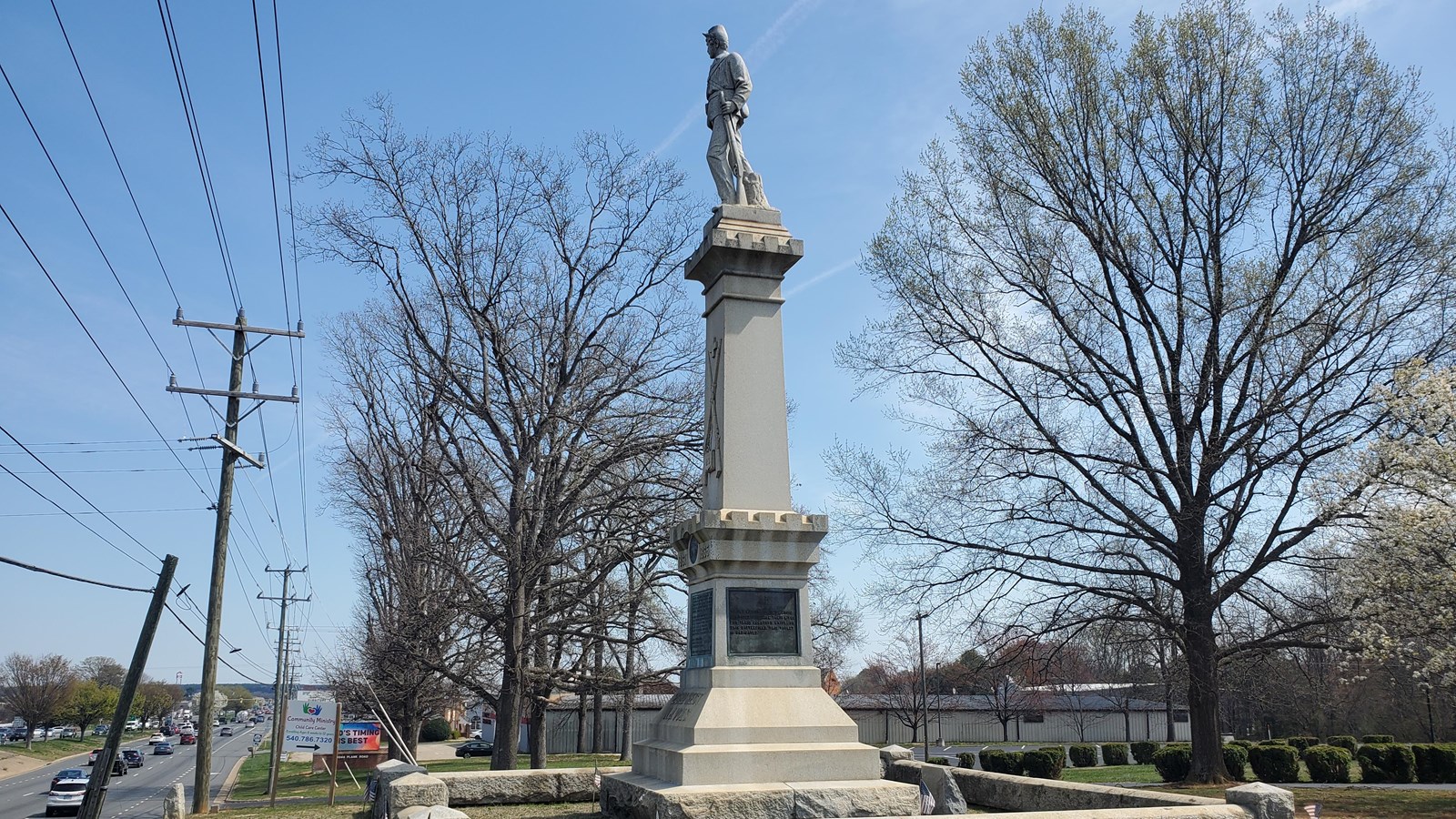Last updated: August 24, 2025
Place
23rd New Jersey Monument

NPS Photo
On May 3, 1863, the Union Sixth Corps broke through a thin Confederate line at Marye’s Heights and pushed westward down the Orange Plank Road toward Chancellorsville. At Salem Church, three miles west of Fredericksburg, Confederate General Lafayette McLaws had deployed 10,000 soldiers across a low, wooded ridge to contest Sedgwick’s advance.
As Union General William H. T. Brooks deployed his brigades into a line of battle to confront McLaws' line, the 23rd New Jersey Volunteers was sent south of the road to support skirmishers of the 2nd New Jersey regiment. The 23rd was a nine-month regiment that was scheduled to be mustered out of service in June.
A little after 5 pm, Brooks gave the order to advance. His line surged up the slope, toward the wooded crest that concealed the Confederate defenders. Colonel E. Burd Grubb, commanding the 23rd New Jersey, had his horse shot from under him and had to lead his men forward on foot. South of the road, near the church, the Federals momentarily gained the crest and broke the Confederate line. The Confederates counterattacked and chased the Federals out of the woods and back down the slope.
The 23rd New Jersey mustered out of service in June, but they would remember the fighting at Salem Church for the rest of their lives. In total, of the one hundred and twenty-six Union soldiers buried here at Salem Church in 1863, only six of them rest in identified graves today. Local organizations oversaw the burial of Confederate soldiers in two nearby Confederate cemeteries. How did the people who fought here and the Salem Church congregants remember this tumultuous period?
Aftermath of War
In 1866, Salem’s congregation returned and made repairs to their church building. Yet, recovery did not solely involve repairing infrastructure or burying the dead. Recovery also meant healing a divided nation. In the postwar era, Salem Church’s physical and social landscape changed dramatically. The site became the focus of veterans’ organizations working to memorialize their actions on the battlefield. The monuments and markers that you see on the grounds today are reminders of the steps that Americans took to remember the actions of soldiers on both sides of the conflict. Yet, they also remind us of the issues that our nation continued to face at the time of their creation.
At the war’s end, former Confederates tried to explain the reason for their defeat by creating a narrative known as the Lost Cause, which argued that the Confederacy did not fight for slavery. The Lost Cause and Southern religious life became intertwined. Many Southern ministers used the Lost Cause to call for racial segregation. Due in part to the Lost Cause’s prevalence, Salem Church only had White members by 1869. Through the rest of the 1800s, the State of Virginia stripped away many of the freedoms granted to Black Americans in 1865.
In this post-war period, veterans of the 23rd New Jersey Infantry Regiment gathered here at Salem Church in 1906 and dedicated the monument in front of you. Consider the words written on the monument’s west side: “to the memory of our heroic comrades, who gave their lives for their Country’s unity….” Consider how creators of monuments chose to remember the Civil War. What unresolved issues did veterans overlook by focusing on a heroic version of the war’s events?
Monument Description
The 20-foot-tall gray granite monument features a stepped base topped by a square die, a square column, and a statue of a Union soldier looking east. On the north side of the monument, facing the road, are the words:N. J. VOLS.
The monument features four large brass plates, one on each side of the square die. The plates bear the following inscriptions:
SERVICES OF THE TWENTY-THIRD
REGIMENT NEW JERSEY VOLUNTEERS
INFANTRY IN THE BATTLE OF SALEM
CHURCH, VIRGINIA, MAY 3RD 1863.
ERECTED BY THE STATE OF NEW JERSEY,
UNDER THE AUTHORITY OF AN ACT PASSED
AT THE SESSION OF 1906, INTRODUCED
IN THE HOUSE OF ASSEMBLY, BY
SAMUEL K. ROBBINS, SPEAKER.
APPROVED BY EDWARD C. STOKES, GOVERNOR.
GENL. E. BURD GRUBB,
CAPT. E. H. KIRKBRIDE, COMMISSIONERS.
Q.M.S. THOMAS J. ALCOTT,
THOMAS MANSON & SON, BUILDERS, RED BANK, N.J.
TO THE MEMORY OF OUR HEROIC
COMRADES, WHO GAVE THEIR LIVES
E. BURD GRUBB.
On the monument’s east side is a tablet that, according to the Daily Star, was the only one in the world that paid “a generous tribute to the foes in whose memory it was reared.” The bronze plaque reads:
OPPONENTS ON THIS FIELD OF
BATTLE, WHOSE MEMORY WE HONOR,
THIS TABLET IS DEDICATED.
FOR THEIR COUNTRY’S UNITY, ON
THIS BATTLEFIELD, THIS TABLET
IS DEDICATED
